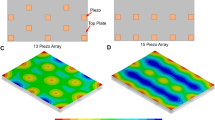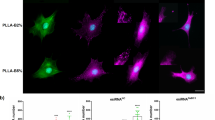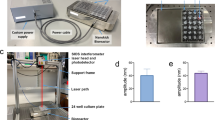Abstract
Bone grafts are one of the most commonly transplanted tissues. However, autologous grafts are in short supply, and can be associated with pain and donor-site morbidity. The creation of tissue-engineered bone grafts could help to fulfil clinical demand and provide a crucial resource for drug screening. Here, we show that vibrations of nanoscale amplitude provided by a newly developed bioreactor can differentiate a potential autologous cell source, mesenchymal stem cells (MSCs), into mineralized tissue in 3D. We demonstrate that nanoscale mechanotransduction can stimulate osteogenesis independently of other environmental factors, such as matrix rigidity. We show this by generating mineralized matrix from MSCs seeded in collagen gels with stiffness an order of magnitude below the stiffness of gels needed to induce bone formation in vitro. Our approach is scalable and can be compatible with 3D scaffolds.
This is a preview of subscription content, access via your institution
Access options
Access Nature and 54 other Nature Portfolio journals
Get Nature+, our best-value online-access subscription
$29.99 / 30 days
cancel any time
Subscribe to this journal
Receive 12 digital issues and online access to articles
$99.00 per year
only $8.25 per issue
Buy this article
- Purchase on Springer Link
- Instant access to full article PDF
Prices may be subject to local taxes which are calculated during checkout







Similar content being viewed by others
Change history
22 November 2017
In the version of this Article originally published, in Fig. 4f, the asterisk was missing; in Fig. 6a–c, the labels ‘Wnt/β-catenin signalling’, ‘Wnt/Ca+ pathway’ and ‘ERK’ and their associated lines/arrows were missing; and in Fig. 6d and in the sentence beginning “In MSCs that were...”, ‘myosin’ and ‘nanostimulated’, respectively, were spelt incorrectly. These errors have now been corrected in all versions of the Article.
References
Giannoudis, P. V., Chris Arts, J. J., Schmidmaier, G. & Larsson, S. What should be the characteristics of the ideal bone graft substitute? Injury42, S1–S2 (2011).
Myeroff, C. & Archdeacon, M. Autogenous bone graft: donor sites and techniques. J. Bone Joint Surg. Am.93, 2227–2236 (2011).
Dimitriou, R., Mataliotakis, G. I., Angoules, A. G., Kanakaris, N. K. & Giannoudis, P. V. Complications following autologous bone graft harvesting from the iliac crest and using the RIA: a systematic review. Injury42, S3–S15 (2011).
Garcia-Gareta, E., Coathup, M. J. & Blunn, G. W. Osteoinduction of bone grafting materials for bone repair and regeneration. Bone81, 112–121 (2015).
Dove, A. Drug screening—beyond the bottleneck. Nat. Biotechnol.17, 859–863 (1999).
Dalby, M. J. et al. The control of human mesenchymal cell differentiation using nanoscale symmetry and disorder. Nat. Mater.6, 997–1003 (2007).
Wen, J. H. et al. Interplay of matrix stiffness and protein tethering in stem cell differentiation. Nat. Mater. 13, 979–987 (2014).
Murphy, W. L., McDevitt, T. C. & Engler, A. J. Materials as stem cell regulators. Nat. Mater.13, 547–557 (2014).
Engler, A. J., Sweeney, H. L., Discher, D. E. & Schwarzbauer, J. E. Extracellular matrix elasticity directs stem cell differentiation. J. Musculoskelet. Neur. Inter.7, 335 (2007).
Curran, J. M. et al. Introducing dip pen nanolithography as a tool for controlling stem cell behaviour: unlocking the potential of the next generation of smart materials in regenerative medicine. Lab Chip10, 1662–1670 (2010).
Kloxin, A. M., Kasko, A. M., Salinas, C. N. & Anseth, K. S. Photodegradable hydrogels for dynamic tuning of physical and chemical properties. Science324, 59–63 (2009).
Benoit, D. S., Schwartz, M. P., Durney, A. R. & Anseth, K. S. Small functional groups for controlled differentiation of hydrogel-encapsulated human mesenchymal stem cells. Nat. Mater.7, 816–823 (2008).
Khetan, S. et al. Degradation-mediated cellular traction directs stem cell fate in covalently crosslinked three-dimensional hydrogels. Nat. Mater.12, 458–465 (2013).
Rauh, J., Milan, F., Gunther, K. P. & Stiehler, M. Bioreactor systems for bone tissue engineering. Tissue Eng. Rev.17, 263–280 (2011).
Epstein, N. E. Complications due to the use of BMP/INFUSE in spine surgery: the evidence continues to mount. Surg. Neurol. Inter.4, S343–S352 (2013).
Salter, E. et al. Bone tissue engineering bioreactors: a role in the clinic? Tissue Eng.18, 62–75 (2012).
Pemberton, G. D. et al. Nanoscale stimulation of osteoblastogenesis from mesenchymal stem cells: nanotopography and nanokicking. Nanomedicine10, 547–560 (2015).
Nikukar, H. et al. Osteogenesis of mesenchymal stem cells by nanoscale mechanotransduction. ACS Nano7, 2758–2767 (2013).
McBeath, R., Pirone, D. M., Nelson, C. M., Bhadriraju, K. & Chen, C. S. Cell shape, cytoskeletal tension, and RhoA regulate stem cell lineage commitment. Dev. Cell6, 483–495 (2004).
Kilian, K. A., Bugarija, B., Lahn, B. T. & Mrksich, M. Geometric cues for directing the differentiation of mesenchymal stem cells. Proc. Natl Acad. Sci. USA107, 4872–4877 (2010).
Abbott, B. P. et al. Observation of gravitational waves from a binary black hole merger. Phys. Rev. Lett.116, 061102 (2016).
Hakansson, B., Brandt, A., Carlsson, P. & Tjellstrom, A. Resonance frequencies of the human skull in vivo. J. Acoustic. Soc. Am.95, 1474–1481 (1994).
Dalby, M. J., Gadegaard, N. & Oreffo, R. O. Harnessing nanotopography and integrin-matrix interactions to influence stem cell fate. Nat. Mater.13, 558–569 (2014).
McNamara, L. E. et al. Skeletal stem cell physiology on functionally distinct titania nanotopographies. Biomaterials32, 7403–7410 (2011).
Yang, J. et al. Nanotopographical induction of osteogenesis through adhesion, bone morphogenic protein cosignaling, and regulation of microRNAs. ACS Nano8, 9941–9953 (2014).
Engler, A. J., Sen, S., Sweeney, H. L. & Discher, D. E. Matrix elasticity directs stem cell lineage specification. Cell126, 677–689 (2006).
Masuyama, R. et al. TRPV4-mediated calcium influx regulates terminal differentiation of osteoclasts. Cell Metab.8, 257–265 (2008).
Coste, B. et al. Piezo proteins are pore-forming subunits of mechanically activated channels. Nature483, 176–181 (2012).
Kim, S. E., Coste, B., Chadha, A., Cook, B. & Patapoutian, A. The role of Drosophila Piezo in mechanical nociception. Nature483, 209–212 (2012).
Kuipers, A. J., Middelbeek, J. & van Leeuwen, F. N. Mechanoregulation of cytoskeletal dynamics by TRP channels. Europ. J. Cell Biol.91, 834–846 (2012).
Bando, Y., Hirano, T. & Tagawa, Y. Dysfunction of KCNK potassium channels impairs neuronal migration in the developing mouse cerebral cortex. Cerebr. Cort.24, 1017–1029 (2014).
Lee, W. et al. Synergy between Piezo1 and Piezo2 channels confers high-strain mechanosensitivity to articular cartilage. Proc. Natl Acad. Sci. USA111, E5114–E5122 (2014).
Zhang, W., Yan, Z., Jan, L. Y. & Jan, Y. N. Sound response mediated by the TRP channels NOMPC, NANCHUNG, and INACTIVE in chordotonal organs of Drosophila larvae. Proc. Natl Acad. Sci. USA110, 13612–13617 (2013).
Maksimovic, S. et al. Epidermal Merkel cells are mechanosensory cells that tune mammalian touch receptors. Nature509, 617–621 (2014).
Lieben, L. & Carmeliet, G. The involvement of TRP channels in bone homeostasis. Front. Endocrinol.3, 99 (2012).
Idris, A. I., Landao-Bassonga, E. & Ralston, S. H. The TRPV1 ion channel antagonist capsazepine inhibits osteoclast and osteoblast differentiation in vitro and ovariectomy induced bone loss in vivo. Bone46, 1089–1099 (2010).
Clapham, D. E. TRP channels as cellular sensors. Nature426, 517–524 (2003).
Bae, C., Sachs, F. & Gottlieb, P. A. The mechanosensitive ion channel Piezo1 is inhibited by the peptide GsMTx4. Biochemistry50, 6295–6300 (2011).
Chen, J. et al. Selective blockade of TRPA1 channel attenuates pathological pain without altering noxious cold sensation or body temperature regulation. Pain152, 1165–1172 (2011).
Lee, L. C. et al. Nanotopography controls cell cycle changes involved with skeletal stem cell self-renewal and multipotency. Biomaterials116, 10–20 (2017).
Ge, C. et al. Reciprocal control of osteogenic and adipogenic differentiation by ERK/MAP kinase phosphorylation of Runx2 and PPARγ transcription factors. J. Cell Physiol.231, 587–596 (2016).
Cheema, U., Chuo, C.-P., Sarathchandra, P., Nazhat, S. N. & Brown, R. A. Engineering functional collagen scaffolds: cyclical loading increases material strength and fibril aggregation. Adv. Func Mater.17, 2426–2431 (2007).
Discher, D. E., Mooney, D. J. & Zandstra, P. W. Growth factors, matrices, and forces combine and control stem cells. Science324, 1673–1677 (2009).
Swift, J. et al. Nuclear lamin-A scales with tissue stiffness and enhances matrix-directed differentiation. Science341, 1240104 (2013).
Huebsch, N. et al. Harnessing traction-mediated manipulation of the cell/matrix interface to control stem-cell fate. Nat. Mater.9, 518–526 (2010).
Lai, V. K., Lake, S. P., Frey, C. R., Tranquillo, R. T. & Barocas, V. H. Mechanical behavior of collagen-fibrin co-gels reflects transition from series to parallel interactions with increasing collagen content. J. Biomech. Eng.134, 011004 (2012).
Gentleman, E. et al. Comparative materials differences revealed in engineered bone as a function of cell-specific differentiation. Nat. Mater.8, 763–770 (2009).
Vandorpe, D. H. & Morris, C. E. Stretch activation of the Aplysia S-channel. J. Membr. Biol.127, 205–214 (1992).
Stein, G. S. & Lian, J. B. Molecular mechanisms mediating proliferation/differentiation interrelationships during progressive development of the osteoblast phenotype. Endocr. Rev.14, 424–442 (1993).
Liu, Y. et al. Hydrogen sulfide maintains mesenchymal stem cell function and bone homeostasis via regulation of Ca2+ channel sulfhydration. Cell Stem Cell15, 66–78 (2014).
Gaur, T. et al. Canonical WNT signaling promotes osteogenesis by directly stimulating Runx2 gene expression. J. Biol. Chem.280, 33132–33140 (2005).
Tsimbouri, P. M. et al. Using nanotopography and metabolomics to identify biochemical effectors of multipotency. ACS Nano6, 10239–10249 (2012).
Agosti, J. K., Chandler, L. A., Anderton, C. M. & Clark, R. M. Serial sharp debridement and formulated collagen gel to treat pressure ulcers in elderly long-term care patients: a case study. Ostomy Wound Manage.59, 43–49 (2013).
Smith, C. A., Want, E. J., O’Maille, G., Abagyan, R. & Siuzdak, G. XCMS: processing mass spectrometry data for metabolite profiling using nonlinear peak alignment, matching, and identification. Anal. Chem.78, 779–787 (2006).
Scheltema, R. A., Jankevics, A., Jansen, R. C., Swertz, M. A. & Breitling, R. PeakML/mzMatch: a file format, Java library, R library, and tool-chain for mass spectrometry data analysis. Anal. Chem.83, 2786–2793 (2011).
Creek, D. J., Jankenevics, A., Burgess, K. V., Breitling, R. & Barrett, M. P. IDEOM: an excel interface for analysis of LC-MS based metabolomics data. Bioinformatics28, 1048–1049 (2012).
Creek, D. J. et al. Toward global metabolomics analysis with hydrophilic interaction liquid chromatography-mass spectrometry: improved metabolite identification by retention time prediction. Anal. Chem.83, 8703–8710 (2011).
Acknowledgements
This work was supported by grants to S.R. and M.J.D. from the BBSRC, BBSRC/SFI and EPSRC (BB/N012690/1, BB/P00220X/1, EP/N013905/1, EP/N012631/1 and EP/P001114/1), along with a Wolfson Merit Award from The Royal Society and a programme grant from Find a Better Way. M.J.P.B. is funded by SFI grant nos. 11/SIRG/B2135 and 13/RC/2073. P.G.C. was funded by an STFC/BBSRC fellowship. We thank J. Hough, H. Nikukar, I. Tifenbrun and K. Robertson for their discussion, C.-A. Smith for technical support, and E. Manson for help with metabolite analysis. We also thank C. Boyle, S. Robertson and P. Campsie for help with the construction of the bioreactor.
Author information
Authors and Affiliations
Contributions
A.S.G.C. was the inspiration behind this work, to whom it is dedicated. P.M.T., P.G.C., G.D.P., J.Y., V.J., W.O., C.G.-G., D.T. and C.V.G. performed the laboratory experiments. P.M.T., P.G.C., G.D.P., W.O., K.B., G.B., M.J.P.B., M.S.-S., S.R. and M.J.D. analysed the data. P.M.T., P.G.C., G.D.P., M.J.P.B., A.S.G.C., M.S.S., S.R. and M.J.D. devised experiments. S.R. and M.J.D. supervised the research. P.M.T., P.G.C., G.D.P., M.S.S., S.R. and M.J.D. wrote the manuscript. P.M.T., P.G.C., S.R. and M.J.D. revised the manuscript.
Corresponding authors
Ethics declarations
Competing interests
The authors declare no competing financial interests.
Additional information
Publisher’s note: Springer Nature remains neutral with regard to jurisdictional claims in published maps and institutional affiliations.
Electronic supplementary material
Supplementary Information
Supplementary figures and tables.
Rights and permissions
About this article
Cite this article
Tsimbouri, P.M., Childs, P.G., Pemberton, G.D. et al. Stimulation of 3D osteogenesis by mesenchymal stem cells using a nanovibrational bioreactor. Nat Biomed Eng 1, 758–770 (2017). https://doi.org/10.1038/s41551-017-0127-4
Received:
Accepted:
Published:
Issue Date:
DOI: https://doi.org/10.1038/s41551-017-0127-4
This article is cited by
-
The functional effects of Piezo channels in mesenchymal stem cells
Stem Cell Research & Therapy (2023)
-
Nanoscale vibration could promote tenogenic differentiation of umbilical cord mesenchymal stem cells
In Vitro Cellular & Developmental Biology - Animal (2023)
-
Vibropolyfection: coupling polymer-mediated gene delivery to mechanical stimulation to enhance transfection of adherent cells
Journal of Nanobiotechnology (2022)
-
Changes in interstitial fluid flow, mass transport and the bone cell response in microgravity and normogravity
Bone Research (2022)
-
Cell-controlled dynamic surfaces for skeletal stem cell growth and differentiation
Scientific Reports (2022)



